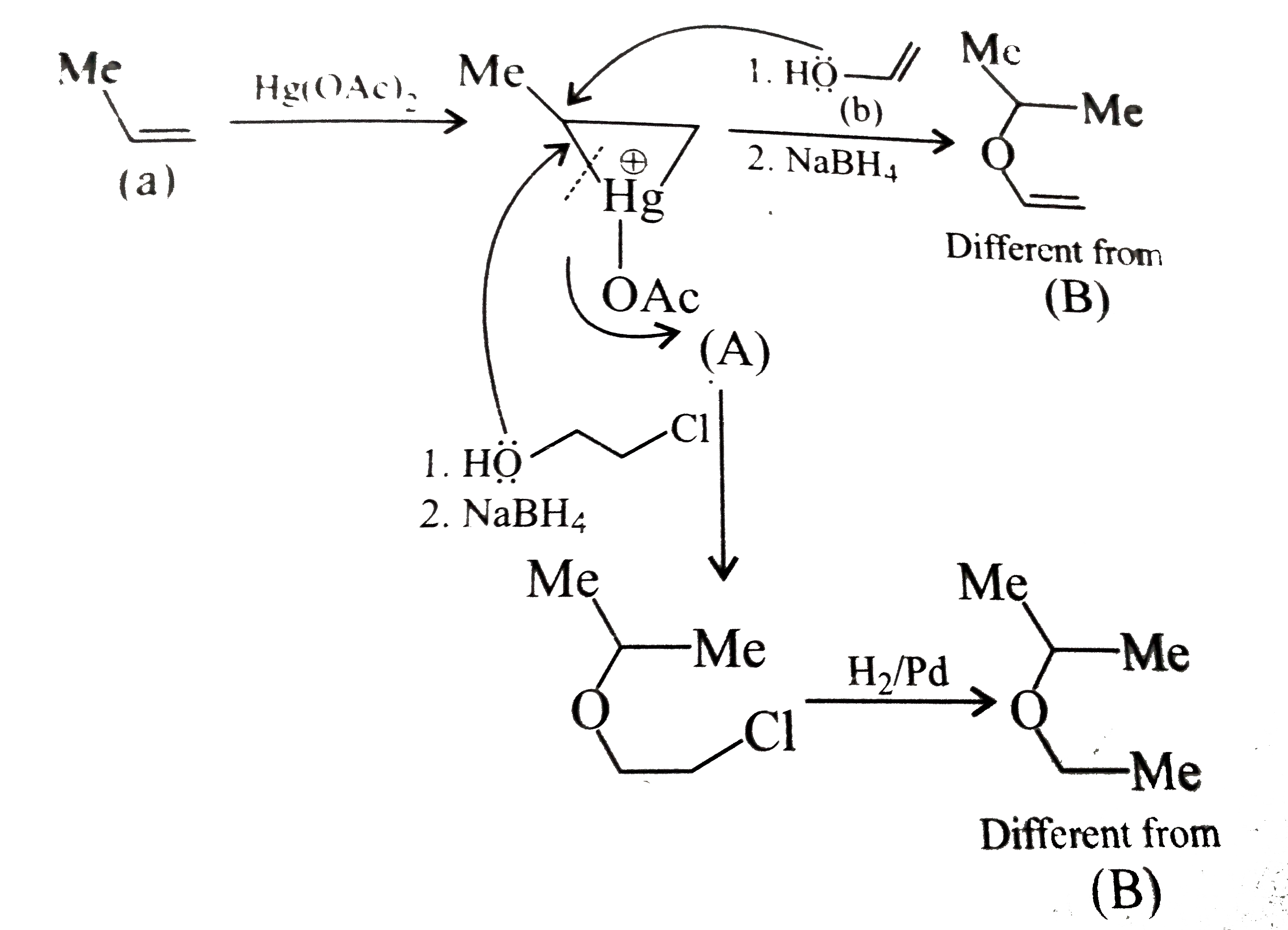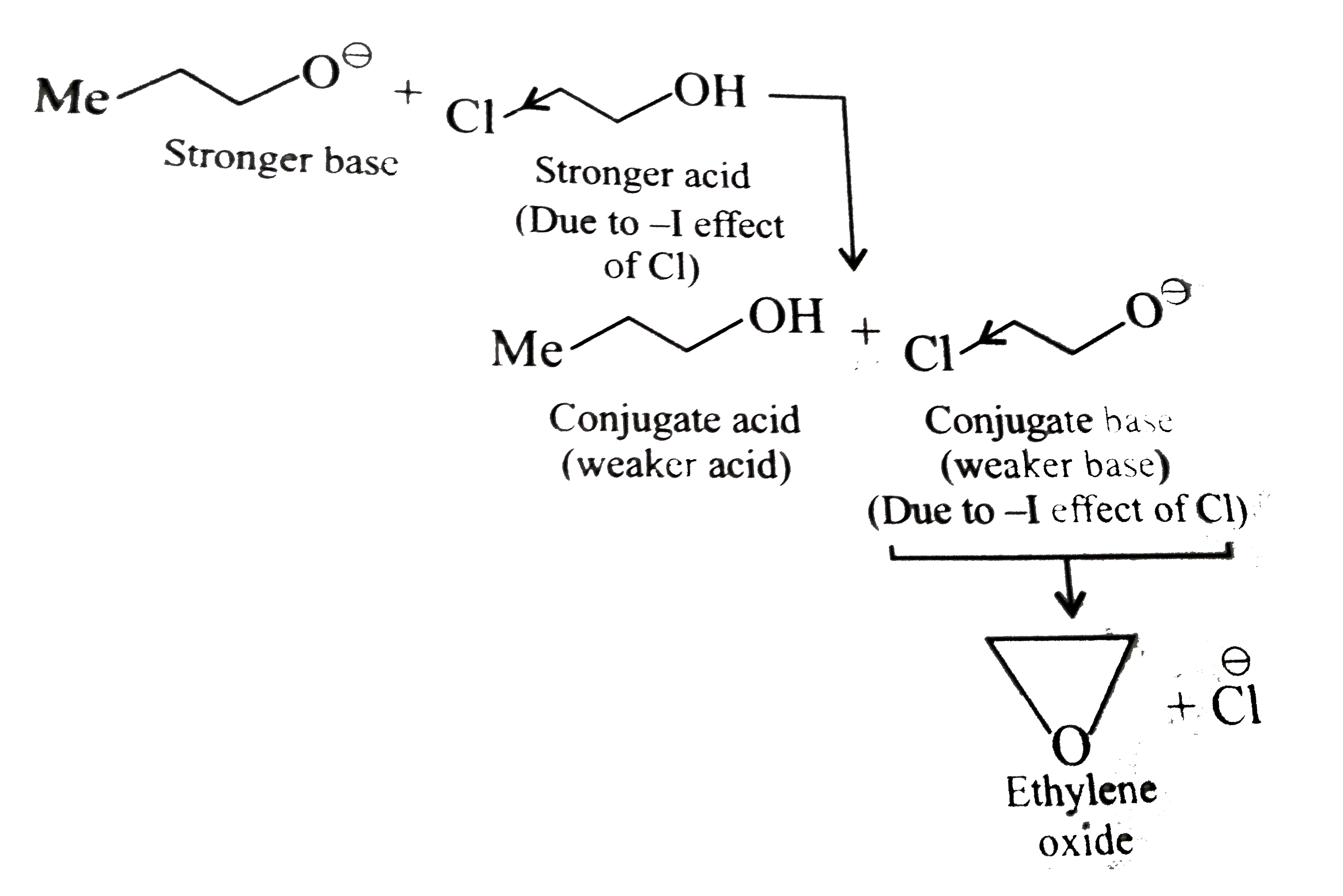Explain why in the synthesis of ether (B) using (A) or A1 all the three standard methods for the perparation of ether (B) fail, i.e.,
I. Intermolecular dehydration of alcohols
II. Alkoxy mercuration-demercuration method
III. williamson's synthesis
Suggest an alternative method for the preparation of (B) by using (A) or (A1) .

i. (B) is an unsymmetrical ether, so method (I) cannot be used.
Method II.
ii. 
Method II of (a) with (b) would give different ethers, Similarly, method II of (a) with (A) would also give different products.

iii. Similarly, method II of (A1)  is not feasible because of the reaction of Hg2+ with CI of (A1).
is not feasible because of the reaction of Hg2+ with CI of (A1).
iv. Williamson's synthesis is also not feasible due to the following reason :
1. 
2. 
3. 
Reaction (3) does not take place, but a Bronsted acid-base reaction occurs giving the epoxide.

Alternative methods for the synthesis of (B) :
i. By nucleophilic addition of RO− to ethtne (HC≡CH)
HC≡CH 
ii. By addition of Br2 in propanol (solvent) to (CH2=CH2)
Topper's Solved these Questions
- ALCOHOL,PHENOL AND ETHERSBOOK - CENGAGE CHEMISTRYCHAPTER - ALCOHOL,PHENOL AND ETHERSEXERCISE - Exercises Subjective
25 Videos
- ALCOHOL,PHENOL AND ETHERSBOOK - CENGAGE CHEMISTRYCHAPTER - ALCOHOL,PHENOL AND ETHERSEXERCISE - Exercises Concept Application
33 Videos
- ALCOHOL,PHENOL AND ETHERSBOOK - CENGAGE CHEMISTRYCHAPTER - ALCOHOL,PHENOL AND ETHERSEXERCISE - Archives Analytical And Descriptive
15 Videos
- ALIPHATIC AND AROMATIC ALDEHYDES AND KETONESBOOK - CENGAGE CHEMISTRYCHAPTER - ALIPHATIC AND AROMATIC ALDEHYDES AND KETONESEXERCISE - Archives Subjective
29 Videos
Similar Questions
(a) Name the reagents and write the chemical equations for the preparation of the following compounds by Williamson's synthesis :
(i) Ethoxybenzene
(ii) 2-Methyl-2-methoxpyropane
(b)Why do phenols not give the protonation reaction readily?
View Solution(a) Name the reagents and write the chemical equations for the preparation of the following compounds by Williamson's synthesis :
(i) Ethoxybenzene
(ii) 2-Methyl-2-methoxpyropane
(b)Why do phenols not give the protonation reaction readily?
View Solution
Knowledge Check
Consider the following methods.
I. Hydration of olefin
II. Hydrolysis of cyanides
III. Reduction of carbonyl compounds
Which of these can be used to prepare alcohols?AI,II and IIBI and IICII and IIIDI and III
Use direct method to evaluate :
(iii) (3b−1)(3b+1)
View SolutionGiven the alcohol and alkene required to prepare the following ethers by alkoxy mercuration-demercuration.
a. Di-se-butyl ether
b. Di-isopropyl ether
c. Di-t-butyl ether
d. 1-Methyl-1-methoxy cyclohexane
e. 1-Phenyl-1-ethoxy propane
View SolutionIn the laboratory preparation of nitric acid from −KNO3orNaNO3 state
(i) the acid used
(ii) the type of apparatus used
(iii) the precautions to be taken during the preparation
(iv) the method of collection of the acid
(v) the method of identification of the product i.e acid fromed.
View SolutionName the method used for preparation of the following salt from the list given below :
List : (A) Simple displacement
(B) Neutralization
(C) Decomposition
(D) Double displacement
(E) Direct synthesis.
Sodium hydrogen sulphate
View SolutionSynthesies the following ethers, selec-ting the given methods.
(I) Williamson's synthesis
(II) Alkoxy mercuration-demercuration
(III) Intermolecular dehydration
Given reasons for the selection of the method.
a. Divinyl ether
b. Dicyclohoexyl ether
c. Propyl sec-butyl ether
d. 1-Propoxy-2-methyl propane
e. 1-(3-Mrthyl butoxy)-3-methyl butane
View SolutionWrite the names of reagents and equations for the preparation of following ethers by Williamson's synthesis :
(i) 1-Methyoxypropane (ii) 2-Ethoxy-2-methylpropane
(iii) Ethoxybenzene
View SolutionSome methods used for the laboratory preparation of salts are :
[A] Metal + acid, [B] Carbonate + acid,
[C] Carbonate + acid, [D] Precipitation [double decomposition] ,
[E] Titration , [F] Direct synthesis.
State the methods of preparation I.e., A, B, C, Dor E for each of the following salts.
Iron (III) chloride
View Solution
